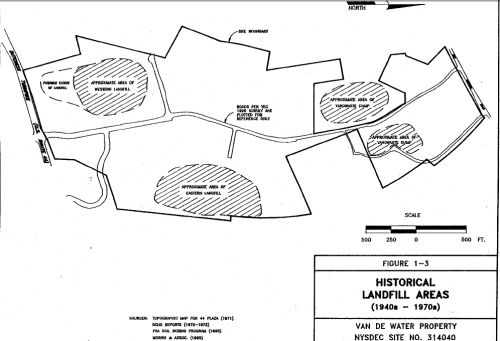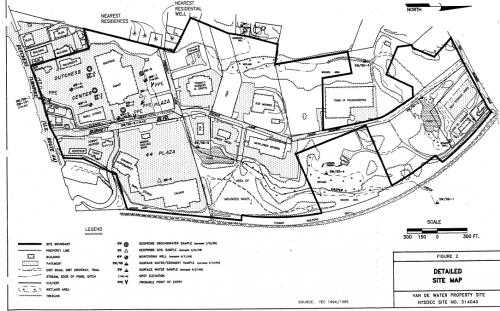The Burnett Boulevard Extension Site: From Brickyard to Landfill to Shopping Plazas
June 10, 2010 by admin
In 1940 John Van De Water leased the land that was once occupied by the Poughkeepsie Brick Corporation to the Town of Poughkeepsie (see The Rise and Fall of “Brickyard Hill”). At that time the 120-acre property was really just an enormous hole in the ground, left from a century and a half of clay mining. The Town proceeded to turn the site into a municipal landfill, which operated from 1948 until 1971. The landfill greatly impacted the surrounding area and several community members have vivid memories of the terrible smells and sights that characterized the site. For example, Ed Lynch, who went to Arlington High School (Arlington Middle School at 601 Dutchess Turnpike previously served as the High School), remarked that he could:
Look out the window (of the school) and see the smoke…Every once in a while the fires would get out of hand and the fire department would have to come and put them out.
Once the landfill closed, development began almost immediately on two shopping plazas—the Route 44 Plaza and the Dutchess Center Plaza. Some of the methods employed during the repaving process were questionable and unchecked by EPA regulations, which has resulted in structural and ecological problems that persist today. These include potential leaking of methane gas, strong odors, and leaching of organic compounds into the surface and ground water of the Casperkill as well as the soil and sediment of the watershed. Although the clay in the site provides a barrier that prevents the majority of the leachate in the landfill from migrating to the creek now, the damage has already been done. Additionally, the shopping plazas have greatly increased amount of trash, engine fluids, and road salt draining directly into the stream.
In his article Our Lovely Casperkill, Dr. A. Scott Warthin, Jr. identifies this Burnett Boulevard Extension site (and especially its transition from a brickyard to a landfill) as the one that has largely determined the current state of the entire Casperkill:
But that hole full of water? What a marvelous place to dump garbage! So a citizen with foresight bought the worthless hole and leased it to the Town of Poughkeepsie for a dump, and the waters that flowed from the swamp down the Casperkill became rich with the organic material of the decaying garbage and charged with iron from the rusting cans. The decay process used up the oxygen normally dissolved in the water; many kinds of life that had swarmed in the stream were drowned in the waters that once nourished them. Some life, however, survived and found that the waters, though fetid, were richer than ever with the decaying organic matter; these things flourished. So the Elodea and waterlilies that once grew in Sunset Lake on Vassar College campus, were replaced by ugly mats of algae. The coliform count of the water grew so high that the Vassar girls had to give up the kayaks in which they once sported. And for years, when the Town burned its dump thrice weekly, a north wind brought a snow of burnt paper ashes on the water… Will the Casperkill ever return to its early state? No, my friend, the marsh wren can never replace the supermarket, so let us have a care for what is left to us before it is too late.

Historical Landfill Areas (1940s-1970s)

Site in 1995. K-Mart is in the upper left corner.
Information from:
Robins, Lucy, 2006. A Look into Past: A Land Use History of the Route 44 Plaza and the Casperkill Watershed, Vassar College.